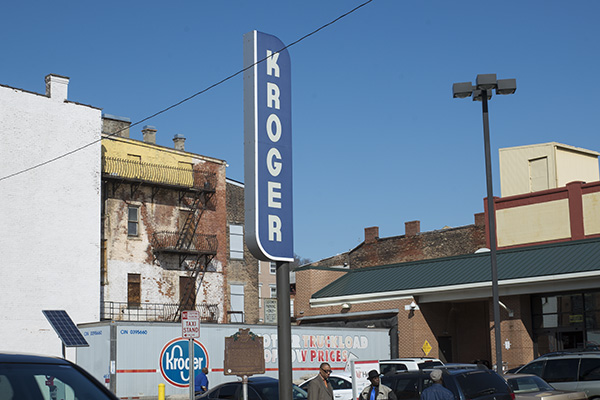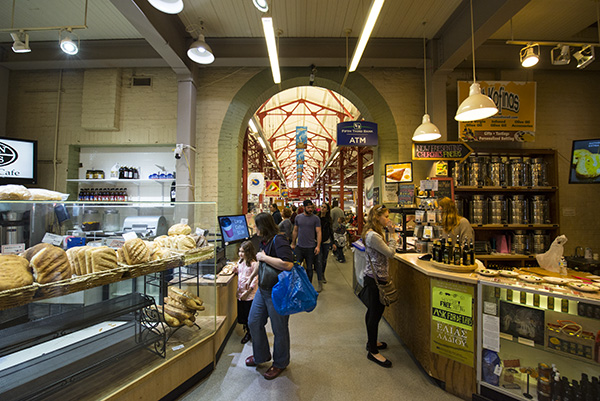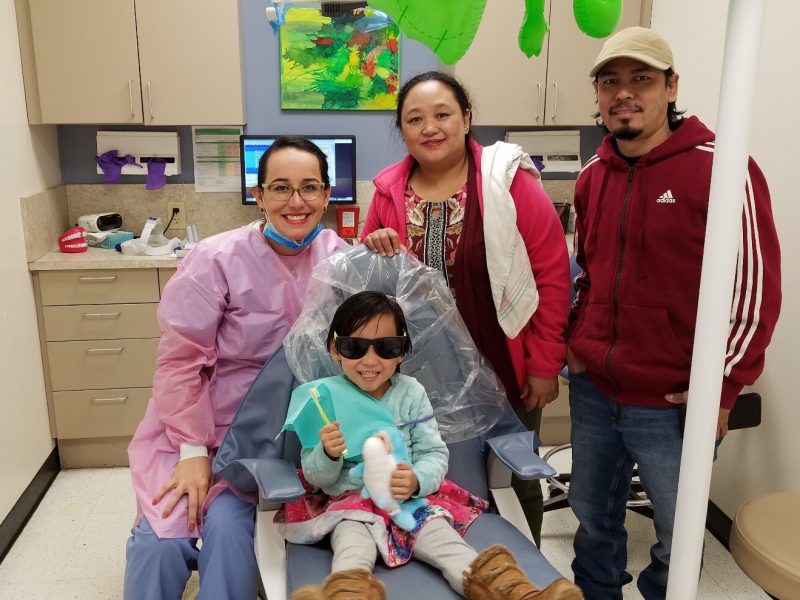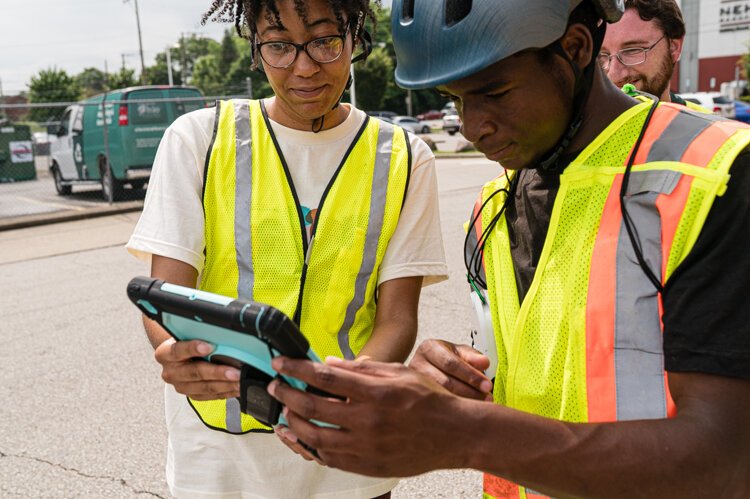Soapdish: Lots of talk, little action on new downtown grocery store
Cincinnati drawing boards are suddenly awash in "downtown grocery store" concepts, but they remain much ado about nothing. Meanwhile, urbanistas make do as we always have.
After years of relative inaction, downtown Cincinnati drawing boards are suddenly awash in “urban grocery store” concepts. No less than five possible grocery stores are kicking about — from Findlay Market to Central Parkway to Fourth Street to The Banks — and that doesn’t even include the great white whale of downtown Cincinnati grocery purveyors, the ever elusive Moby Kroger.
That’s right, America’s largest supermarket chain, the fifth largest retailer in the world whose global world headquarters casts a long shadow over downtown Cincinnati, still doesn’t have a downtown grocery store.
Here’s the news roundup in case you haven’t been paying attention:
• Splashy renderings show a (possibly but not confirmed Kroger) grocery store in the old CMHA location at Central Parkway near Vine Street;
• The Fresh Table folks at Findlay Market have announced plans to open a small sundries store in the Model Group development across the street on Race;
• The new owner/developer of 309 Vine Street has bandied about plans for a small grocery operation;
• Fourth and Race seems to have lost its grocery in the wake of Mayor Cranley’s scaled-down plans for the site;
• The new owner of the Daniel Burnham-designed Fourth and Walnut Centre has discussed his desire to bring a grocer into the project to complement the two hotels planned for the structure;
• Blue Ash-based Rookwood Properties has been pushing the site at Central Parkway and Walnut Street as a potential grocery site since 2014;
• And back in November 2014 Lucky’s Market was scouting the former Merten Printing site on Central Parkway as a possible new development.
It’s the humble opinion of this Soapdish columnist that the Central Parkway and Walnut Street site, located as it is on the Cincinnati Streetcar route, is the primo, ultimate, ne plus ultra of downtown grocery options. The unattractive surface parking lot there sits in the bullseye between downtown and Over-the-Rhine, convenient to commuters and residents alike.
Soapdish surveyed the local downtown grocery scene back in Fall 2008, and a recent update reveals that not much has changed. To be honest, I’ve never really believed that downtown really had such a pressing need for its own grocery store.
As I observed in 2008: “In this sense … the elusive Downtown Grocery Store is something of a canard, a straw man (or woman, if you will). It is simply a weak excuse to not move downtown. People in the suburbs often drive more than four miles from the edge of their cul-de-sac to a grocery store, so if you hear someone carping about not being able to live downtown because there’s nowhere to buy groceries, rest assured there are other reasons for their intransigence.
“Admittedly, a downtown grocery store would certainly make a difference from a cosmetic standpoint and is certainly both welcome and necessary in order to move the urban resurgence forward, but its heft as a substantive tipping point is open to debate.”
There are four Kroger stores within two miles or less of downtown. There are CVS and Walgreen spots that function as de facto general stores. There’s a “green” general store at Park + Vine. There’s a Family Dollar on Central Parkway to handle miscellaneous items. Most importantly, there are Findlay Market and the Vine Street Kroger in Over-the-Rhine, where you can pretty much cover all of your shopping needs in one walkable or bikable trip.
Ah yes, Findlay Market. Named for Gen. James Findlay, a veteran of the War of 1812 and former mayor of Cincinnati. The General was a major landowner in the “Northern Liberties” and, prior to his death in 1836, intended to start a farmer’s market at Elder Street and a store nearby but died before he could do so. After his wife passed away in 1847, the executors of his estate donated the land for a public market to be named after him.
This would be the Cincinnati’s seventh public market building at the time, with construction beginning in 1852, yet it was the first public market outside the city core. The other markets tended to be clustered closer to the river, but Findlay Market saw the need to service some of the growing populations north and west of the downtown basin.
Contrary to the prevailing masonry-oriented tendencies of the time, City Civil Engineer Alfred West Gilbert directed that this market house be constructed of iron, a common concept in 1850s Great Britain but a novel idea in Cincinnati. Many believed that it wouldn’t work, and although the project was delayed slightly the Findlay Market shed emerged as one of the first iron market buildings in the U.S. and the oldest in Ohio.
At the time of its completion in 1855, public markets were flourishing, and by 1860 there were nine in Cincinnati alone. These weren’t just places to procure provisions but also social centers for interaction and communing with your neighbors.
They were the mid-19th Century equivalent of a shopping center, but so much more vibrant and diverse (just as Findlay Market on weekends has become today). As transportation options drew people away from the basin, however, neighborhood business districts began to supplant the public markets, and the apex of the public market was clearly in the rear view mirror.
Court Street also had a wooden market house dating back to the 1860s, convenient due to its proximity to the Miami & Erie Canal. That shed, between Vine and Walnut, was demolished around 1915, but an infrequent curbside market existed well into the 2000s, then slowly faded away with little fanfare. All that’s left is a 1980s-style planned rejuvenation (“Court Street Marketplace”) with brick sidewalks, portable sidewalk stalls that went unused and a bell tower with a replica of the old Court Street Market bell that was to ring at the start of market days every Tuesday and Thursday.
History lessons aside, it makes sense that much of the discussion of a potential new downtown grocery store seems to center around Central Parkway, Court and Vine/Walnut, a centralized location in the basin, on the streetcar route and accessible by car as well as foot. Coincidentally enough, that’s also where Kroger’s headquarters is located.
Ah yes, Kroger again. It’s the 10-ton elephant in the room, the global grocery colossus whose sole foray into downtown groceries is the 12,000-square-foot Vine Street store, one of the smallest in its empire.
I shop at the Vine Street Kroger multiple times each week, and its improvement in the past eight years or so has been extensive and well documented. It’s no longer famous solely for its extensive variety of 40-ouncers.
The store managers have been responsive to requests, with better quality produce and variety of products (still no Swiffers, which I don’t get). But it remains a 12,000-square-foot store with an absolute eyesore of a parking lot as its gateway.
Meanwhile, Kroger subsidiaries like Ralph’s, QFC and Fred Meyer operate multiple glitzy urban showcase grocery stores that make the Vine Street Kroger look like a red-headed stepchild. Every new Kroger acquisition (including its most recent purchase of Mariano’s in Chicago) rekindles a firestorm of speculation among local urbanistas that they’ll test market the brand in downtown Cincinnati. Then, just as quickly as rumors began to circulate, they’re snuffed out.
The recent stories, however, seem to have more staying power than past pipe dreams about a Trader Joe’s or Whole Foods. Until then, however, we can get by as we always do.
We’ll walk or ride bikes to Findlay Market and Vine Street Kroger, then stop at a butcher shop on Court Street or a hardware store on Main Street. We’ll make a quick trip to Walgreen’s at Sixth and Race and swing through Park + Vine on the way home.
It’s really not that hard to find your urban grocery store if you know where to look.




















